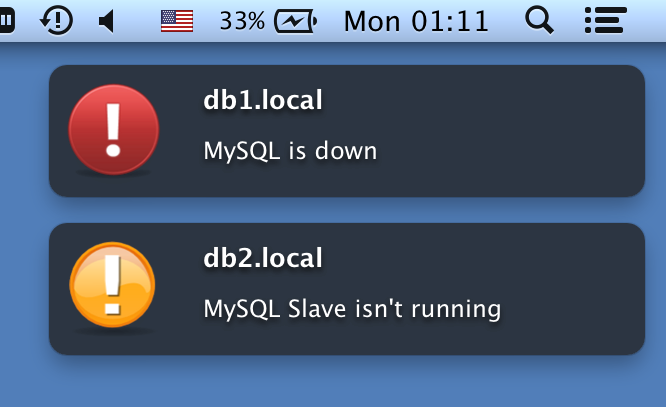Well, thanks to a new Jailbreak tweak, this could be very possible. ForwardNotifier is a recently-released, free jailbreak tweak that allows users with jailbroken iPhones to forwards notifications to their PC (Mac and Linux only for now) or iOS device (tested on iOS 9-13 for the receiver part). ElementaryOS has the following feature to notify the user of a finished terminal process. Is it possible to use this feature in Ubuntu? Figure 1: Example of eOS terminal notification.
- Applescript Display Alert
- Terminal-notifier Change Icon
- Terminal-notifier Windows
- Terminal-notifier
- Terminal-notifier Display Notification
- Terminal-notifier Python
- Terminal Notifier Mac
#45899closeddefect (fixed)

| Reported by: | Owned by: | raimue (Rainer Müller) | |
|---|---|---|---|
| Priority: | Normal | Milestone: | |
| Component: | ports | Version: | 2.3.2 |
| Keywords: | Cc: | ||
| Port: | terminal-notifier |
Description
Attachments (1)
- terminal-notifier.main.log (19.9 KB) - added by petrrr6 years ago.
- main.log
Download all attachments as: .zip
Change History (7)
Changed 6 years ago by petrrr
comment:1 Changed 6 years ago by seanfarley (Sean Farley)
comment:2 Changed 6 years ago by petrrr
comment:3 Changed 6 years ago by raimue (Rainer Müller)
comment:4 Changed 6 years ago by petrrr
comment:5 Changed 6 years ago by petrrr
comment:6 Changed 6 years ago by raimue (Rainer Müller)
terminal-notifier is a command-line tool to send macOS User Notifications,which are available on macOS 10.10 and higher.
News
Applescript Display Alert
alerter features were merged in terminal-notifier 1.7. This led to some issues and even more issues in the 1.8 release. We decided with Valère Jeantet to rollback this merge.
From now on terminal-notifier won't have the sticky notification feature nor the actions buttons. If you need them please use alerter. I also want to follow semver hence this latest version starts at 2.0.0.
Sticking to two smaller specialized tools will hopefully make them easier to maintain and less error prone.
Caveats
It is currently packaged as an application bundle, because
NSUserNotificationdoes not work from a ‘Foundation tool’. radar://11956694If you intend to package terminal-notifier with your app to distribute it on the Mac App Store, please use 1.5.2; version 1.6.0+ uses a private method override, which is not allowed in the App Store Guidelines.
If you're using macOS < 10.10 you should use terminal-notifier 1.6.3.
If you're looking for sticky notifications or more actions on a notification please use alerter
Download
Prebuilt binaries are available from thereleases section.
Or if you want to use this fromRuby, you caninstall it through RubyGems:
You can also install it via Homebrew:
Usage
In order to use terminal-notifier, you have to call the binary inside theapplication bundle.
The Ruby gem, which wraps this tool, does have a bin wrapper. If installedyou can simply do:
This will obviously be a bit slower than using the tool without the wrapper.
If you'd like notifications to stay on the screen until dismissed, go to System Preferences -> Notifications -> terminal-notifier and change the style from Banners to Alerts. You cannot do this on a per-notification basis.
Example Uses
Display piped data with a sound:
Use a custom icon:
Open an URL when the notification is clicked:
Open an app when the notification is clicked:
Options
At a minimum, you must specify either the -message , the -remove, or the-list option.
-message VALUE[required]
The message body of the notification.
If you pipe data into terminal-notifier, you can omit this option,and the piped data will become the message body instead.
-title VALUE
The title of the notification. This defaults to ‘Terminal’.
-subtitle VALUE
The subtitle of the notification.
-sound NAME
Play the NAME sound when the notification appears.Sound names are listed in Sound Preferences.
Use the special NAME “default” for the default notification sound.
-group ID
Specifies the notification’s ‘group’. For any ‘group’, only onenotification will ever be shown, replacing previously posted notifications.
A notification can be explicitly removed with the -remove option (seebelow).
Terminal-notifier Change Icon
Example group IDs:
- The sender’s name (to scope the notifications by tool).
- The sender’s process ID (to scope the notifications by a unique process).
- The current working directory (to scope notifications by project).
-remove ID[required]
Remove a previous notification from the ID ‘group’, if one exists.
Use the special ID “ALL” to remove all messages.
-list ID[required]
Lists details about the specified ‘group’ ID.
Use the special ID “ALL” to list details about all currently active messages.
The output of this command is tab-separated, which makes it easy to parse.
-activate ID
Activate the application specified by ID when the user clicks thenotification.

Terminal-notifier Windows
You can find the bundle identifier (CFBundleIdentifier) of an application in its Info.plist fileinside the application bundle.
Examples application IDs are:
Terminal-notifier
com.apple.Terminalto activate Terminal.appcom.apple.Safarito activate Safari.app
-sender ID
Fakes the sender application of the notification. This uses the specifiedapplication’s icon, and will launch it when the notification is clicked.
Using this option fakes the sender application, so that the notification systemwill launch that application when the notification is clicked. Because of thisit is important to note that you cannot combine this with options like-execute and -activate which depend on the sender of the notification to be‘terminal-notifier’ to perform its work.
For information on the ID, see the -activate option.
-appIcon PATH
Terminal-notifier Display Notification
Specify an image PATH to display instead of the application icon.
WARNING: This option is subject to change, since it relies on a private method.
-contentImage PATH
Specify an image PATH to attach inside of the notification.
WARNING: This option is subject to change since it relies on a private method.
Terminal-notifier Python
-open URL
Open URL when the user clicks the notification. This can be a web or file URL,or any custom URL scheme.
-execute COMMAND
Run the shell command COMMAND when the user clicks the notification.
-ignoreDnD
Ignore Do Not Disturb settings and unconditionally show the notification.
WARNING: This option is subject to change since it relies on a private method.
License
All the works are available under the MIT license. Except for‘Terminal.icns’, which is a copy of Apple’s Terminal.app icon and as such iscopyright of Apple.
Copyright (C) 2012-2017 Eloy Durán eloy.de.enige@gmail.com, Julien Blanchardjulien@sideburns.eu
Permission is hereby granted, free of charge, to any person obtaining a copy ofthis software and associated documentation files (the 'Software'), to deal inthe Software without restriction, including without limitation the rights touse, copy, modify, merge, publish, distribute, sublicense, and/or sell copiesof the Software, and to permit persons to whom the Software is furnished to doso, subject to the following conditions:
Terminal Notifier Mac
The above copyright notice and this permission notice shall be included in allcopies or substantial portions of the Software.
THE SOFTWARE IS PROVIDED 'AS IS', WITHOUT WARRANTY OF ANY KIND, EXPRESS ORIMPLIED, INCLUDING BUT NOT LIMITED TO THE WARRANTIES OF MERCHANTABILITY,FITNESS FOR A PARTICULAR PURPOSE AND NONINFRINGEMENT. IN NO EVENT SHALL THEAUTHORS OR COPYRIGHT HOLDERS BE LIABLE FOR ANY CLAIM, DAMAGES OR OTHERLIABILITY, WHETHER IN AN ACTION OF CONTRACT, TORT OR OTHERWISE, ARISING FROM,OUT OF OR IN CONNECTION WITH THE SOFTWARE OR THE USE OR OTHER DEALINGS IN THESOFTWARE.
